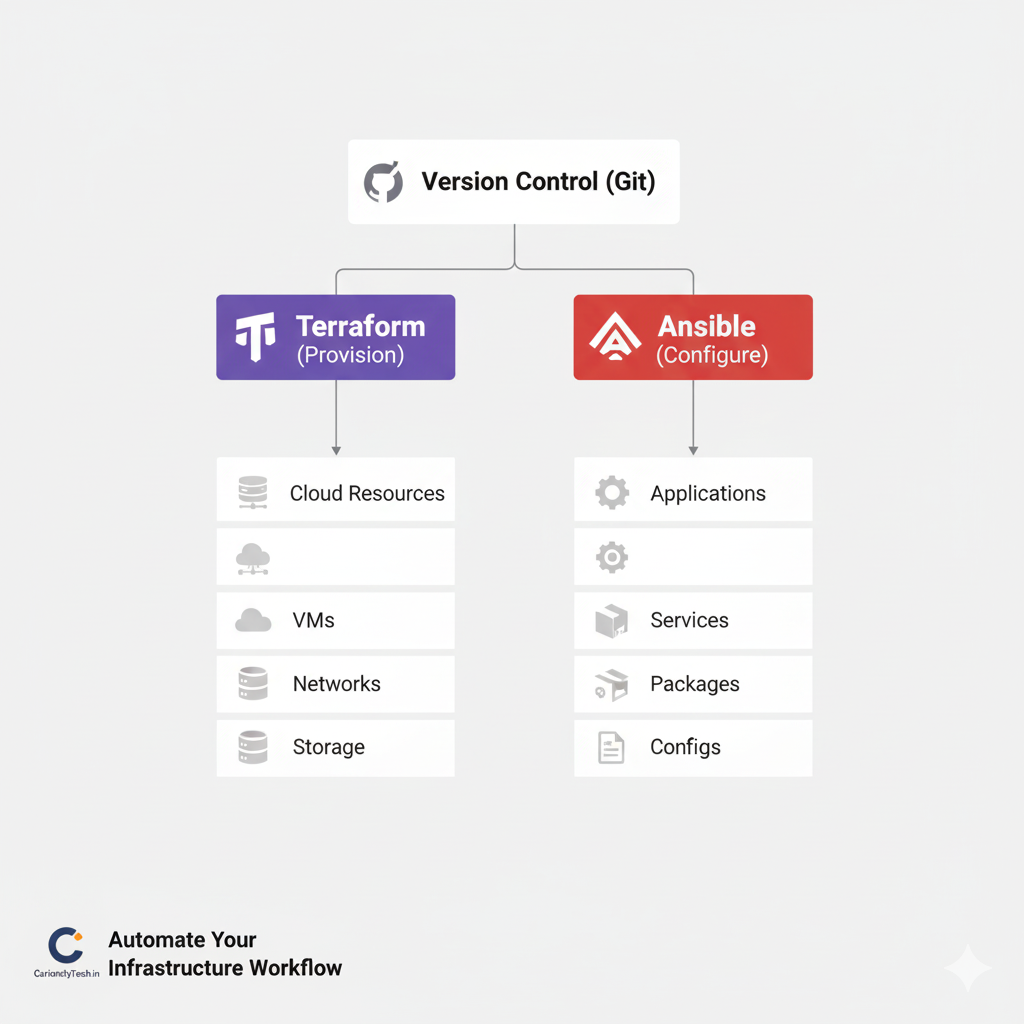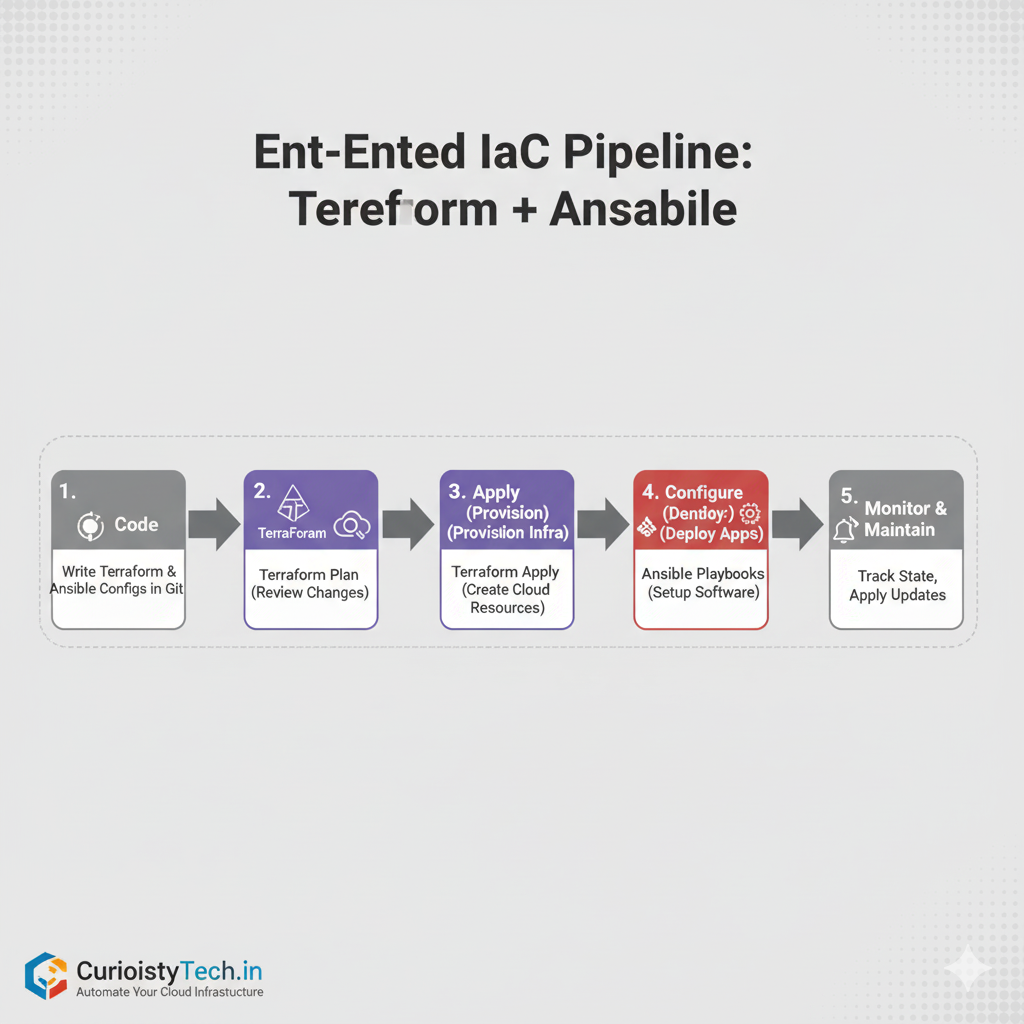Introduction
In today’s DevOps world, Infrastructure as Code (IaC) has changed the way engineers manage and set up IT infrastructure.
Instead of manually configuring servers and networks, IaC lets teams define everything using code—making deployments consistent, repeatable, and easy to scale.
At CuriosityTech.in, we focus on teaching IaC not just for automation, but to help build strong, cloud-native environments.
What is Infrastructure as Code (IaC)?
IaC means using code (instead of manual steps) to manage and create infrastructure.
It helps DevOps teams to:
- Automate setup and configuration
- Keep environments consistent (dev, test, prod)
- Reduce mistakes and downtime
- Track changes using version control (like Git)
Think of IaC as a blueprint written in code—every server, database, and network is described clearly, either declaratively or imperatively.
Types of IaC
| IaC Type | Description | Example Tools |
|---|---|---|
| Declarative | You define the end result you want. The system figures out how. | Terraform, Kubernetes Manifests |
| Imperative | You give step-by-step instructions. | Ansible, Chef, Puppet |
Terraform vs Ansible
Two popular IaC tools are Terraform and Ansible. They have different purposes but can work together.
| Feature | Terraform | Ansible |
|---|---|---|
| Type | Declarative | Imperative |
| Primary Use | Provisioning infrastructure (VMs, networks, etc.) | Configuring systems and deploying apps |
| State Management | Tracks state using files | Stateless (depends on idempotent playbooks) |
| Supported Platforms | AWS, Azure, GCP, Kubernetes, VMware | Linux, Windows, network devices |
| Learning Curve | Medium | Easy to Medium |
| Best For | Infrastructure provisioning | Configuration and orchestration |
IaC Workflow (Terraform & Ansible)

Terraform: Declarative Infrastructure Provisioning
Terraform uses HCL (HashiCorp Configuration Language) to define cloud infrastructure.
Workflow:
- Write Config Files – Define VMs, networks, storage
- Initialize –
terraform initto download plugins - Plan –
terraform planto preview changes - Apply –
terraform applyto deploy resources - Manage State – Use
terraform.tfstateto track changes
Example – AWS EC2 instance:
provider "aws" {
region = "us-east-1"
}
resource "aws_instance" "web_server" {
ami = "ami-0c94855ba95c71c99"
instance_type = "t2.micro"
tags = {
Name = "WebServer"
}
}
At CuriosityTech.in, learners start by provisioning VMs and networks in AWS or GCP using Terraform.
Ansible: Imperative Configuration Management
Ansible is a simple, agentless tool for configuring systems and deploying apps. It uses YAML playbooks that are easy to read and write.
Workflow:
- Install Ansible –
pip install ansible - Define Inventory – List of servers
- Write Playbooks – Define tasks in YAML
- Run –
ansible-playbook site.yml
Example – Install Nginx:
- hosts: webservers
become: yes
tasks:
- name: Install Nginx
apt:
name: nginx
state: present
- name: Start Nginx
service:
name: nginx
state: started
Best Practices for IaC
- Use Version Control (Git) – Track changes
- Start Small – One VM or container
- Combine Terraform + Ansible – Provision with Terraform, configure with Ansible
- Test Changes – Use staging before production
- Ensure Idempotency – Scripts should run multiple times without breaking anything
At CuriosityTech.in, students do hands-on labs to simulate real-world DevOps work.
Challenges & Solutions
| Challenge | Solution |
|---|---|
| Large Environment Complexity | Use modules in Terraform and roles in Ansible |
| Managing State | Store state remotely (e.g., AWS S3 for Terraform) |
| Learning Curve | Start small, grow complexity step-by-step |
| Configuration Drift | Reapply playbooks regularly to keep systems aligned |
End-to-End IaC Pipeline (Infographic Summary)

Conclusion
Infrastructure as Code (IaC) helps DevOps teams manage cloud infrastructure efficiently. Tools like Terraform and Ansible make it easier to automate and scale deployments.
To master IaC, engineers need:
- Knowledge of both declarative and imperative approaches
- Hands-on experience in cloud environments
- Integration into CI/CD pipelines
At CuriosityTech.in, we train learners to provision, configure, and manage real cloud infrastructure using these tools—so they’re ready for enterprise DevOps roles.
By practicing real-world scenarios, engineers gain the skills to build scalable, secure, and reliable systems from the ground up.

